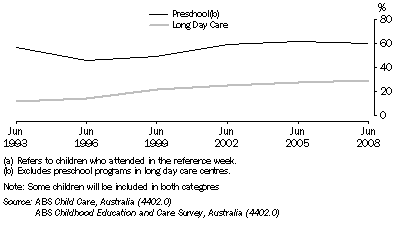EARLY CHILDHOOD EDUCATION
Early childhood education in Australia encompasses early learning programs in preschools and other organisations, and the skills development of children from birth onwards. A number of studies at the domestic and international level have noted that young children who do not have appropriate learning opportunities may suffer from adverse outcomes later in life, although difficulties may be overcome by quality interventions which support families and individuals. Research also indicates that a child's brain undergoes the most rapid development in the first five years of life, reaching the peak of their learning potential up to the age of 8 years. This has prompted educational providers to introduce formal programs to maximise the uptake of basic skills in the early years. Such programs, aimed at raising children's readiness for school, are generally available in preschool and in a range of child care settings.
Of the 1,028,000 children aged 4-8 years who attended school in June 2008, 82% usually attended a preschool or a preschool program in long day care in the year prior to attending school. Of those children who usually attended, parents reported that 94% made a good adjustment to school compared to 88% of children that did not attend either preschool or a preschool program in long day care in the year prior to attending school. See Childhood Education and Care, Australia, June 2008 (4402.0) on the ABS website.
Preschool students
Preschool generally refers to structured educational programs that are provided for children in the year prior to commencing full-time primary education; it excludes preschool programs that are run in long day care centres . The responsibility for providing preschool education rests with individual states and territories. Preschools may be operated by government, community organisations or the private sector.
Similar educational programs or curricula may be provided in long day child care centres and other settings. Preschool programs in long day care centres are structured and planned as part of an early childhood education program with specific educational aims and objectives. The program aims to meet the educational and developmental needs of children who are at least 3 years of age, although some younger children may be involved in such programs.
According to the 2008 ABS Childhood Education and Care Survey, 257,200 children attended preschool in the reference week, with 4 year olds representing 61% of this total. The 4 year olds attending preschool in the reference week amounted to 60% of all 4 years olds surveyed. In contrast, only 11% of 5 year olds surveyed attended preschool in the reference week, which reflects the fact that most 5 year olds have entered primary school by that age.
Graph 12.1 shows that the proportion of 4 year olds attending preschool has fluctuated between 1993 and 2008, while the proportion attending long day care centres has increased steadily (from 12% in 1993 to 30% in 2008).
12.1 PARTICIPATION OF FOUR YEAR OLDS(a), June

The National Preschool Census (NPC), conducted annually for the Department of Education, Employment and Workplace Relations, collects information about the number of children attending preschools, which are registered providers and have a preschool educational program. The NPC found that there were 215,500 children enrolled in preschool in August 2008, an increase of 1% from the previous year's enrolments. Government preschools held 24% of enrolled children.
Indigenous preschool students
The NPC provides a basis for the allocation of Australian Government funding to preschools in which Indigenous students are enrolled. The 2008 NPC reported 10,014 Indigenous children enrolled in government and non-government preschools, representing 5% of total preschool enrolments. Of these Indigenous enrolments, 28% were in New South Wales. Between 2007 and 2008, the number of Indigenous children enrolled in preschools increased by 4%, and the number of non-Indigenous enrolments increased by 1% (table 12.2). Indigenous enrolments were reported by 1,819 preschools or 39% of preschools. Fifty-three percent of Indigenous preschoolers were enrolled in government preschools.
12.2 INDIGENOUS PRESCHOOL ENROLMENTS |
|
 | 2003 | 2004 | 2005 | 2006 | 2007 | 2008 |
|
| New South Wales | 2 694 | 2 672 | 2 773 | 2 763 | 2 679 | 2 780 |
| Victoria | 559 | 535 | 523 | 597 | 589 | 677 |
| Queensland(a) | 896 | 862 | 738 | 810 | 1 301 | 1 347 |
| South Australia | 1 114 | 1 148 | 1 047 | 1 066 | 1 097 | 1 297 |
| Western Australia | 1 834 | 1 858 | 1 905 | 2 127 | 1 981 | 2 042 |
| Tasmania | 331 | 341 | 356 | 322 | 358 | 324 |
| Northern Territory | 1 535 | 1 544 | 1 543 | 1 477 | 1 519 | 1 399 |
| Australian Capital Territory | 88 | 95 | 134 | 113 | 103 | 148 |
| Total Indigenous enrolments | 9 051 | 9 055 | 9 019 | 9 275 | 9 627 | 10 014 |
| Total non-Indigenous enrolments | 202 576 | 205 004 | 212 653 | 203 723 | 202 775 | 205 512 |
|
| (a) Excludes children who were in Queensland's part-time Pre Year 1 program that was delivered by schools before 2007. This program was expanded to a full-time program in 2007 and is now considered a primary school program. |
| Source: Department of Education, Employment and Workplace Relations (DEEWR), 'National Preschool Census'. |
 Print Page
Print Page